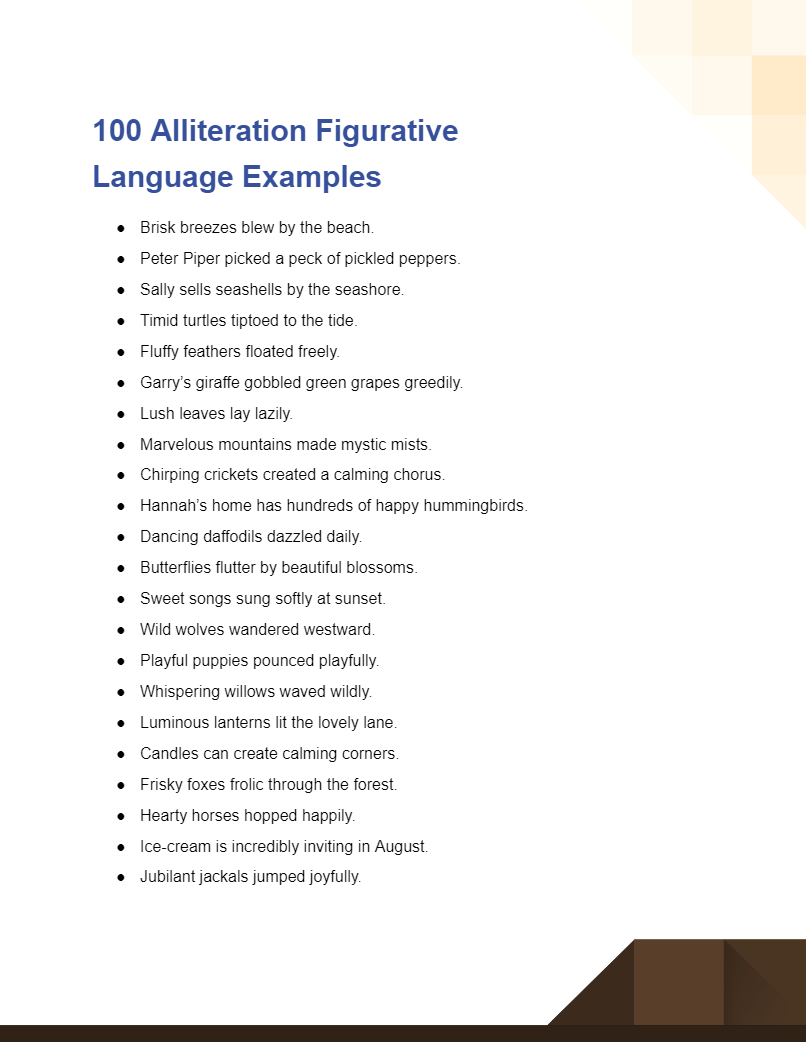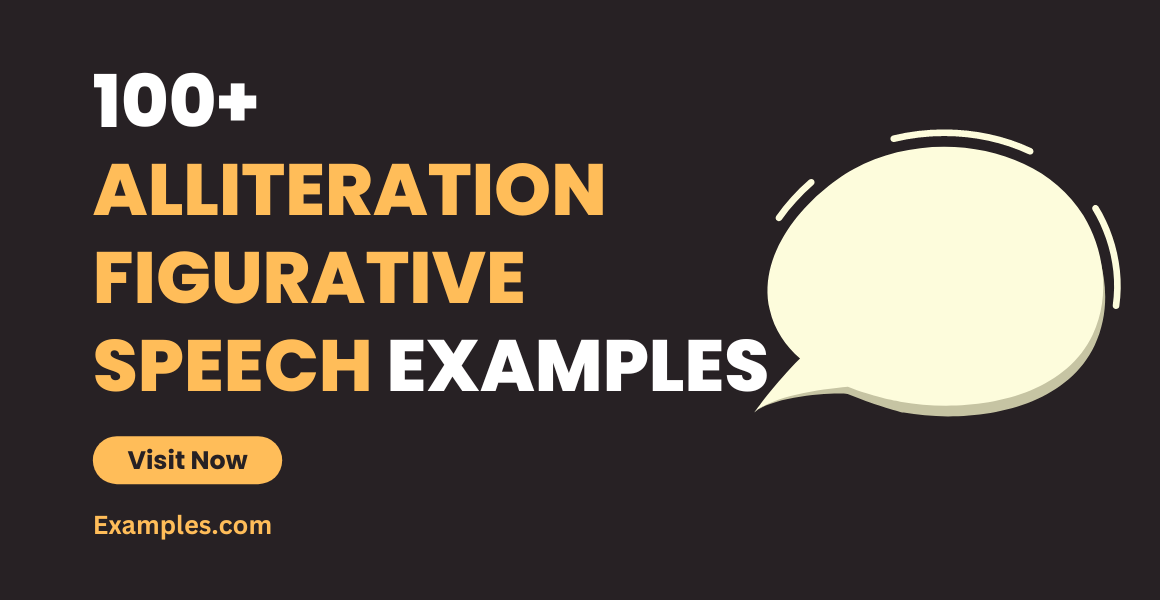100+ Alliteration Figurative Language Examples
Alliteration, with its rhythmic repetition of consonant sounds, has long been a beloved tool in the poetic toolbox. But when combined with figurative language, it elevates expression to an entirely new level, adding depth and musicality to imagery and ideas. From the gentle whispers of a breezy beach to the tumultuous turmoil of tempestuous times, the fusion of alliteration examples with figurative phrases brings a lyrical luster to literature. Dive into this melodious realm and explore how to weave these elements seamlessly into your own writings.
What is an Alliteration in Figurative Language?
100 Alliteration Figurative Language Examples

Alliteration in figurative language elevates prose and poetry by emphasizing rhythmic patterns and crafting memorable lines. This technique, revolving around the repetition of initial consonant sounds, not only enhances auditory appeal but also deepens the reader’s engagement by creating a harmonious resonance. Dive into these enticing examples to explore the lyrical allure of alliteration.
- Brisk breezes blew by the beach.
- Peter Piper picked a peck of pickled peppers.
- Sally sells seashells by the seashore.
- Timid turtles tiptoed to the tide.
- Fluffy feathers floated freely.
- Garry’s giraffe gobbled green grapes greedily.
- Lush leaves lay lazily.
- Marvelous mountains made mystic mists.
- Chirping crickets created a calming chorus.
- Hannah’s home has hundreds of happy hummingbirds.
- Dancing daffodils dazzled daily.
- Butterflies flutter by beautiful blossoms.
- Sweet songs sung softly at sunset.
- Wild wolves wandered westward.
- Playful puppies pounced playfully.
- Whispering willows waved wildly.
- Luminous lanterns lit the lovely lane.
- Candles can create calming corners.
- Frisky foxes frolic through the forest.
- Hearty horses hopped happily.
- Ice-cream is incredibly inviting in August.
- Jubilant jackals jumped joyfully.
- Kitty’s kite kept kissing the clouds.
- Llamas like leisurely lounging.
- Majestic eagles make many marvelous maneuvers.
- Nifty newts navigate nightly.
- Overgrown oaks overshadow old orchards.
- Perky parrots perch proudly.
- Quirky quails quickly quacked.
- Radiant rainbows rise regularly.
- Silly squirrels scrambled swiftly.
- Thundering thoughts throbbed through.
- Under umbrellas, unicorns united.
- Vexed vultures vanished vaguely.
- Wily weasels weave without warning.
- Exquisite examples excite every expert.
- Yearning yaks yelled yesterday.
- Zigzagging zebras zoomed zestfully.
- Fantastic fairies found fallen ferns.
- Gigantic gorillas grinned graciously.
- Hooting owls haunted hollow hills.
- Imaginative iguanas illustrated islands.
- Joyful jellyfish jigged jubilantly.
- Knocking knees knew no knowledge.
- Lions lounged lazily, looking leonine.
- Mischievous monkeys made massive messes.
- Noble newts nodded negatively.
- Observant owls overlooked outlying outskirts.
- Purring pussycats pranced precariously.
- Quizzical queens queried quickly.
- Roaring rivers ran rapidly.
- Swooping sparrows sang sweet serenades.
- The thirsty thrush thought thoroughly.
- Uplifting ukuleles unified unknown universes.
- Vivacious violets veered very visibly.
- Wonderful whales whistled while whirling.
- Xeroxed xenon x-rayed xenial xylophones.
- Young yellow yachts yielded yonder.
- Zealous zeppelins zoomed zealously.
- Round rabbits raced round rugged rocks.
- Stars silently shimmered, shining splendidly.
- Tall trees towered, touching the top.
- Vain vipers voiced varied views.
- Waterfall’s wild waters washed wading walruses.
- Excited elves eagerly explored everywhere.
- Yawning yaks yearned yummy yams.
- Zigzag zippers zipped zero zucchinis.
- Big blue balloons begin bouncing.
- Cheerful children chatted, choosing chocolate chip cookies.
- Deep dark dungeons do dampen dreams.
- Every evening, eagles eagerly eat eels.
- Fiery foxes fiercely fight for food.
- Great gray gorillas grow green grapes.
- Happy hares hop, having hearty hops.
- Interesting insects inhabit isolated islands.
- Jumpy jaguars jest, joining jolly jigs.
- Kooky kangaroos kick kettles, keeping kinks.
- Lucky lemurs love licking luscious lollipops.
- Mighty meerkats munch many mushrooms.
- Nightingales never notice naughty narwhals.
- Observant octopuses occupy ocean openings.
- Proud peacocks parade, preening plumage perfectly.
- Quaint quails quit quickly, quarreling quietly.
- Radiant roses really rouse romantics.
- Slippery seals slide, seeking seaweed snacks.
- Tiny turtles tiptoe to the tidal tank.
- Unruly unicorns usually undertake unusual undertakings.
- Vocal vultures voice various verses.
- Wobbly weasels waddle, watching walnuts wobble.
- Xerophilous xerophytes xeroxed xanthic xeroxes.
- Youthful yodelers yodeled, yielding yodeling yo-yos.
- Zealot zebras zigzagged, zapping zeppelin zones.
- Babbling brooks brought brisk breezes.
- Cunning cats caught curious carp.
- Diligent dogs dig deep ditches.
- Eager elephants elegantly eat elderberries.
- Fidgety frogs flee from frigid fjords.
- Graceful geese glide, gathering green grain.
- Hearty hawks hover, hunting hares hungrily.
- Intrepid iguanas inhabit icy igloos.
Hard Alliteration Activity Examples
Hard Alliteration will Engage in interactive linguistic play. Craft catchy sentences, create challenges, and unleash your imagination. Transform consonant sounds into captivating melodies.
- Rhyme and Riddle: Formulate rhyming riddles to stump friends.
- Story Starters: Begin stories with alliteration-rich sentences.
- Alphabet Adventures: Write paragraphs for each alphabet letter.
- Alliteration Challenge: Set a timer for sentence creation.
- Character Creations: Invent alliterative character names.
- Nature’s Notes: Describe scenes with vivid alliteration.
- Food Fusion: Combine culinary terms in a feast of sounds.
- Historical Happenings: Recreate history with alliterative flair.
- Travel Tales: Craft alliterative travel anecdotes.
- Musical Medleys: Write song lyrics with dynamic alliteration.
Hard Alliteration Tongue Twister Examples
Tackle intricate tongue twisters filled with alliteration. Test pronunciation and enjoy twisting words playfully.
- Sylvia’s Sizzling Sausages: Sylvia sells sausages in San Francisco.
- Crazy Cats: Careless cats chase cunning canaries.
- Fluttering Fairies: Fairies frolic in the fragrant forest.
- Bobby’s Bubbly Bath: Boisterous Bobby bathes in bubbly basins.
- Rapid Rivers: Raging rivers rush through ravines.
- Mystic Moonlight: Mystical moonlight magnifies midnight.
- Slippery Snakes: Slippery snakes silently slither.
- Wally’s Whimsical Wishes: Wally wishes for wacky wonders.
- Giddy Goblins: Giddy goblins gather gleaming gems.
- Dizzying Dance: Daring dancers dazzle with dizzy dips.
Hard Alliteration Examples in Poems/Poetry
Experience melodic beauty in poetic alliteration. Feel rhythm and imagery from strategic consonant sounds.
- Whispering Winds: Wild winds wail through willow trees, Creating an enchanting summer’s breeze.
- Echoes of Evening: Evening echoes embrace Earth, Awakening artistry’s rebirth.
- Starry Serenade: Shimmering stars silently sing, Serenading the universe in cosmic rhythm.
- Mystical Moonbeams: Moonbeams mingle with midnight, Melodies in the night’s tragic delight.
- Luminous Lullaby: Lustrous lanterns light lanes, Lulling the world to sleep’s sweet refrain.
- Dreamer’s Dance: Dazzling dreams drift deep, Dancing desires that never sleep.
- Whispers of Winter: Wandering winds weave wilderness, Whispering tales of winters and memories.
- River’s Rhyme: Rushing river’s rhythm roars, Reflecting nature’s narrative on shores.
- Floral Fantasy: Fragrant flowers flourish in fields, Filling air with a fragrance rare.
- Sunrise Symphony: Silken sunrise spills soft gold, Serenading Earth as day unfolds.
Hard Alliteration Examples with Consonant Sounds
Experience consonant combinations in alliteration. Examples showcase versatility and impact.
- Percussive Parade: Pounding percussion pulses in parade.
- Sizzling Sounds: Sizzling sausages send scents skyward.
- Whimsical Whispers: Whimsical whispers weave wind tales.
- Rugged Rapids: Rugged rapids rage in ravine.
- Chiming Charms: Chiming church bells charm children.
- Velvet Voices: Velvet voices vibrate with verses.
- Glistening Gems: Glistening gems glitter with glow.
- Crackling Campfire: Crackling campfire casts cozy warmth.
- Flickering Flames: Flickering flames fan festive fervor.
- Radiant Rainbows: Radiant rainbows reach rolling horizon.
How do you write an alliteration figurative language? – A Step by Step Guide
Alliteration is a poetic device where the first consonant sounds in close-proximity words are repeated. When used effectively, it can add a musical quality to a piece, making it more memorable and rhythmic. Here’s a step-by-step guide to crafting beautiful alliteration in figurative language:
1. Understand the Purpose:
Before you begin, understand why you want to use alliteration. Is it to make a poem more rhythmic, to emphasize a particular point, or to create a mood or tone?
2. Choose Your Subject:
Determine the subject of your sentence or poem. Having a clear subject can guide the direction of your alliteration.
3. List Down Words:
Brainstorm and write down words related to your subject. At this stage, don’t worry about alliteration; just focus on collecting words.
4. Identify Potential Alliterative Sounds:
From your list, identify consonant sounds that have multiple corresponding words. For instance, if you have “moon”, “mountain”, and “mystic”, the ‘m’ sound is your potential alliterative sound.
5. Construct Your Sentence or Verse:
Begin crafting your sentence or verse. Try to place your alliterative words close together. This proximity is crucial for the alliteration to be noticeable.
6. Read Aloud:
Alliteration’s impact is best felt when it’s heard. Read your sentence or verse aloud to ensure the repeated sounds flow well.
7. Refine and Revise:
If something doesn’t sound right or feels forced, tweak it. Alliteration should feel natural and not overly contrived.
8. Incorporate Other Figurative Elements:
Alliteration works best when combined with other poetic devices, like metaphors, similes, or assonance. This creates a richer, more layered effect.
9. Seek Feedback:
Share your work with someone else. Fresh ears can often catch nuances you might have missed.
10. Practice Regularly:
Like any skill, the more you practice writing alliterations, the better you’ll get at it.
Tips for Writing Alliteration Figurative Language
- Avoid Overuse: While alliteration can be impactful, overusing it can make your writing sound redundant or juvenile. Strive for balance.
- Combine with Other Devices: As mentioned, combining alliteration with other figurative language devices can create more depth in your writing.
- Stay Relevant: Ensure that the words you’re using for the sake of alliteration are relevant to your subject or theme.
- Flexibility is Key: If an alliterative phrase doesn’t work, don’t force it. It’s okay to adjust your approach.
- Expand Your Vocabulary: The more words you know, the more tools you have at your disposal. Reading widely can introduce you to new words perfect for alliteration.
- Maintain Clarity: While playing with sounds, ensure that the meaning of your sentence or verse remains clear.
- Experiment with Sounds: Don’t just stick to the obvious sounds. Sometimes, subtle alliteration can be more impactful.
- Use Alliteration Sparingly in Prose: If you’re writing a story or an essay, too much alliteration can be distracting. However, sprinkling it in at just the right moments can make your prose more engaging.
- Stay Authentic: Alliteration should enhance your writing, not define it. Stay true to your voice and use alliteration where it fits naturally.
- Enjoy the Process: The joy of writing comes from experimentation. Enjoy playing with sounds and words, and don’t be afraid to make mistakes. That’s how growth happens!


